Top 10 Things to Do in Morocco
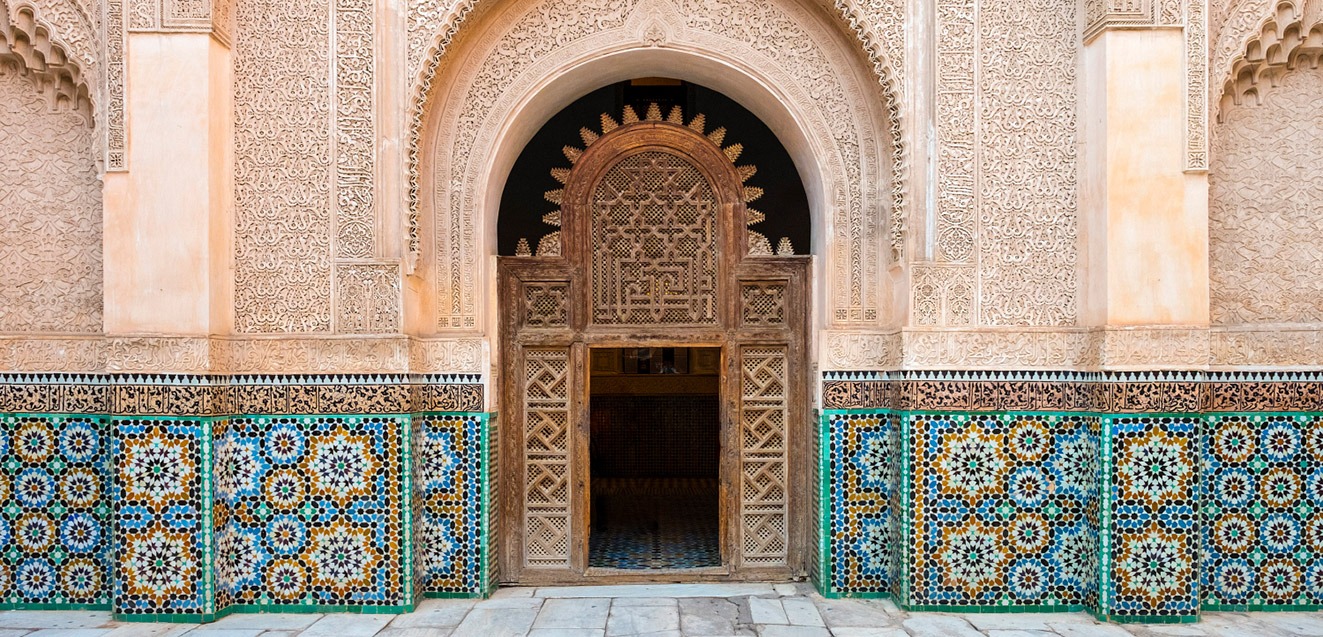
It’s a country of vibrant colors, intoxicating scents, diverse landscapes, and delicious cuisine. While winding medinas, exotic spices, and illustrious cities are what Morocco adventure travel is known for, there’s also plenty to see, do, and taste that may be well off your radar. From calligraphy workshops to wide sandy beaches to artisan-led tours of ancient souks, here are 10 things to do in the country that highlight Morocco’s best adventures and points of interest, as well as its most exciting lesser-known finds.
1. Stay in a classic riad in Marrakech
Traditional homes and palaces built around open-air courtyards, riads are brimming with intricate features such as tadelakt plasterwork, geometric zellij tiles, and dazzling central fountains. A stay in one of these historic structures is a quintessential Moroccan experience. Marrakech is home to some of the country’s most impressive restored riads. The lovely Villa des Orangers is a tranquil five-star oasis that stands at the foot of the city’s largest mosque.
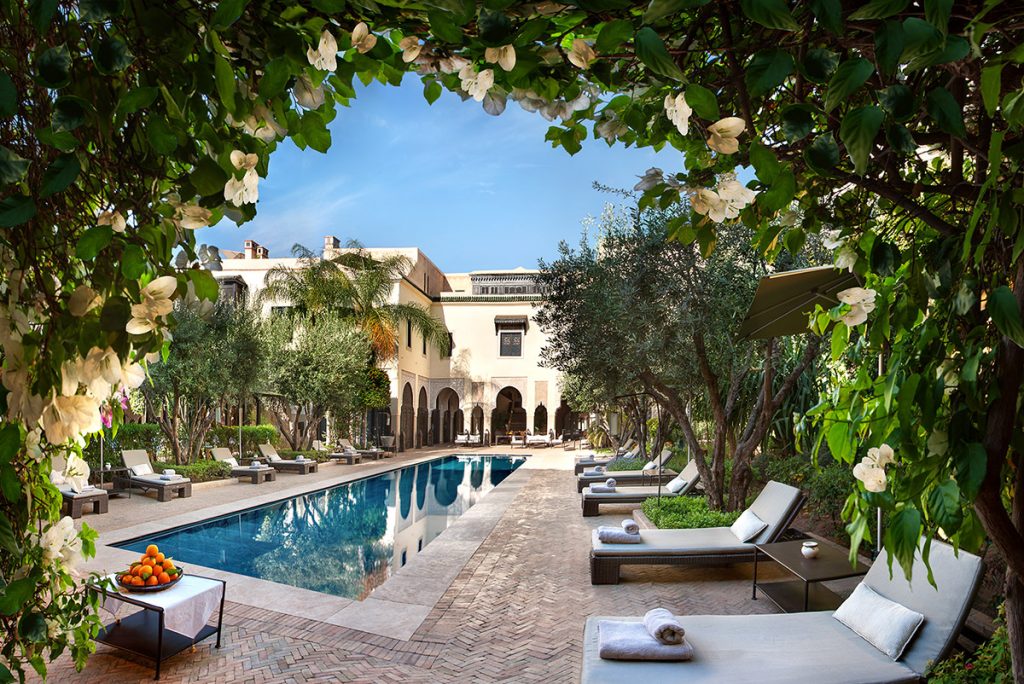
Built in the 1930s, the property served as a private residence until 1998, when the current owners transformed it into a majestic lodging replete with top-notch amenities, including three swimming pools, a gourmet restaurant serving Moroccan dishes like braised rabbit and chicken tagine, and its very own hammam. Of course, a stay here offers modern conveniences, such as air conditioning and high-speed Wi-Fi, as well, making it an ideal perch to base your explorations.
2. Answer the call of the desert at Erg Chebbi Dunes
From its fertile date palm valleys to its sandy, sun-drenched beaches, Morocco is home to an array of spectacular natural landscapes. One of the most impressive is the Erg Chebbi Dunes, whose undulating, wind-blown sands rise to 820 feet in some places. For the full Erg Chebbi experience, bed down at one of the Berber-style tent camps that dot the terrain. We at GeoEx are big fans of Desert Luxury Camp, where handcrafted furnishings and Berber rugs grace spacious en suite tents set on a sea of gold and apricot sands. From this base, there are a myriad of ways to take in the surrounding scenery.

Explore Erg Chebbi’s rolling peaks on camelback, gather around an evening campfire while enjoying the rhythmic chants of traditional gnawa music, or join a professional astronomer who will introduce you to the wonders of a constellation-filled sky.
3. Take tea with a Berber family in the High Atlas Mountains
Stretching diagonally across central Morocco for more than 600 miles, the High Atlas Mountains not only are impressive, they also offer an entirely different view of Morocco than its cities, showcasing the country’s quieter, more tranquil side. Along with rising peaks and secluded valleys like Ouirgane, known for its distinct red rock formations, and Imlil, teeming with walnut trees and apple orchards, hiking and walking opportunities abound. This vast expanse is also home to Berbers, Morocco’s indigenous people, who will welcome you into their villages with steaming cups of refreshing mint tea. Later, spend the night at your own mountain oasis: one of the High Atlas’s many refurbished casbahs.
4. Purify your body and mind at a traditional hammam and spa in Skoura
When it comes to illuminating Morocco attractions, visiting a hammam is an experience that awakens the senses and connects travelers to the culture. This traditional type of bath house exists throughout northern Africa and the Middle East, and in Morocco, dates back to at least the 8th century. The country’s hammams offer a great way to soak in local culture, literally, through a series of steams, scrubs, and pools. Opt for a classic hammam ritual, like the one offered at Dar Ahlam Spa in the town of Skoura, one of Morocco’s most verdant oasis valleys. The three-part offering consists of an exfoliating scrub, a rejuvenating body wrap, and a relaxing “Eastern-style” massage. Refreshing cups of mint tea are typically on hand to complete this oh-so-revitalizing experience.
5. Find the perfect souvenir in Marrakech
Your guide is your key when it comes to shopping in Morocco, where bargaining is an artform. These seasoned pros can assist you with everything from finding truly authentic items to negotiating fair prices that will leave both parties happy. Consider emailing your shopping wish list to GeoEx in advance so that your guide knows whether it’s modern design or classic handicrafts that most excite you and can schedule stops at the best markets and ateliers for you to discover.
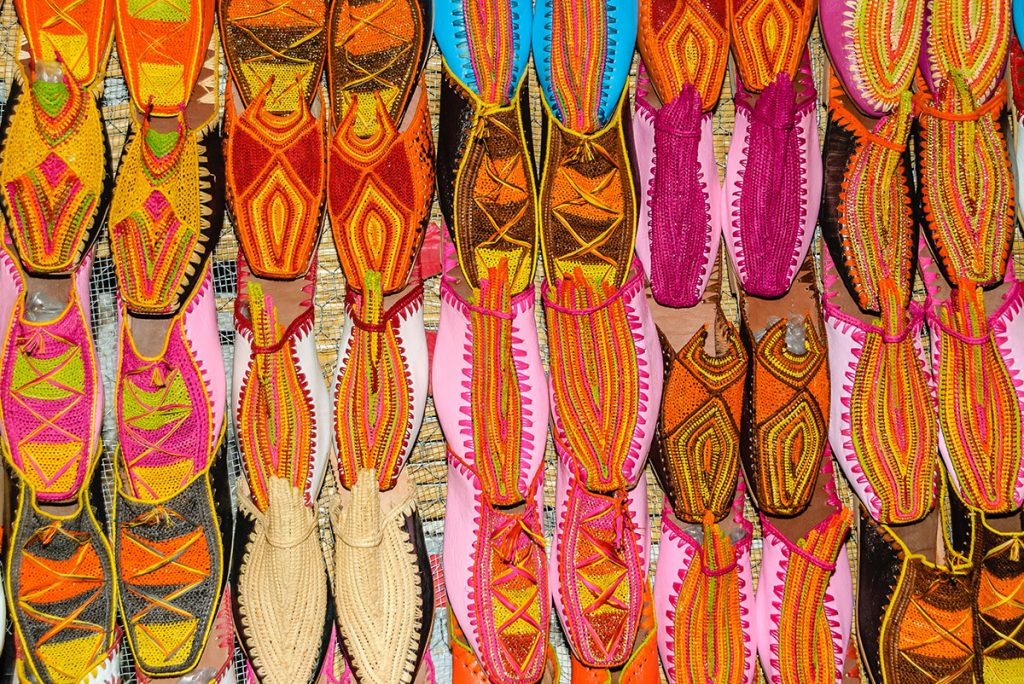
We can even arrange a well-informed shopping guide to assist you on a particular quest, whisking you directly to vintage goods like handcrafted lanterns and babouche slippers in the heart of Marrakech’s mesmerizing medina, or designer kaftans and artisan embroidered bed linens in its modern Gueliz neighborhood, where European styles are the norm.
6. Immerse yourself in traditional arts in Fès
The walled old town of Fès is a labyrinth of narrow, car-free alleyways lined with fonduks (ancient inns for traveling merchants) and madrassas from the 13th and 14th centuries, and arguably one of the best places to visit in Morocco. It’s home to local artisans and craftspeople that are carrying on some of the country’s time-honored traditions. Known as Morocco’s “cultural and spiritual capital,” Fès is famous for its leather products, such as the belts, wallets, and handbags made onsite at the city’s nearly 1,000-year-old Chouara, the largest and one of the oldest tanneries in town. Here, you can view a leather-making process that dates back centuries (rooftops are often the best places to get an overview of the dyeing tanks), then wander about town taking in other artisan crafts, including bookbinding, copper working, and carpet making.
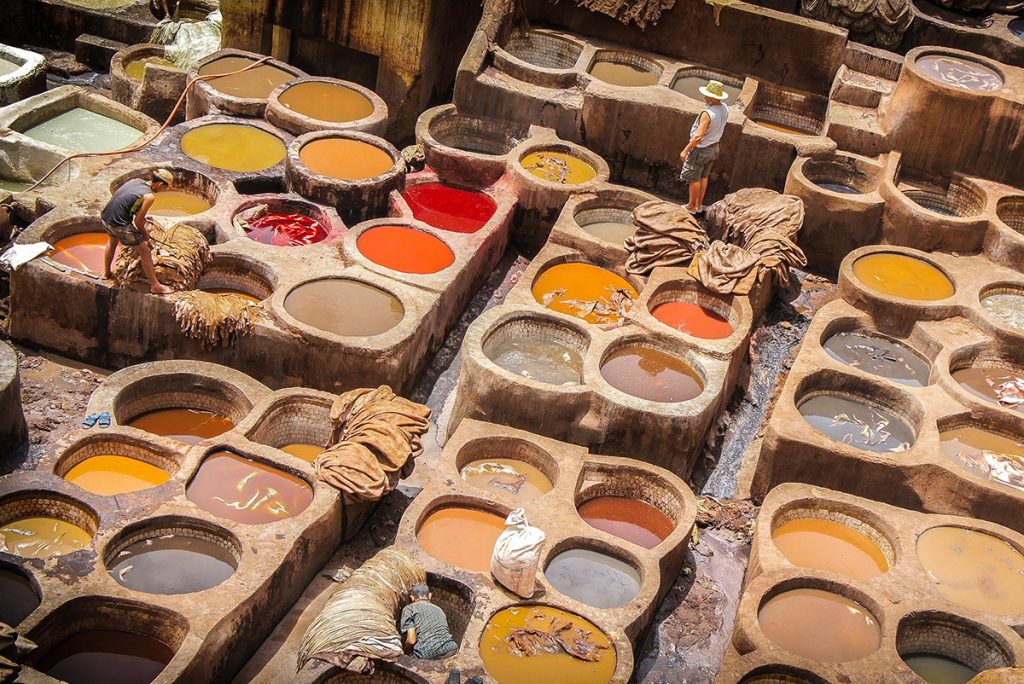
Go even deeper with an artisan-led tour of the various workshops, which provides an expert and insightful look at what goes into making these many intricately crafted designs. Bespoke experiences, such as trying your hand at Islamic calligraphy, or making and painting traditional Fassi pottery in Ain Nokbi (aka Fès’ potters’ quarter), located just beyond the medina, are superb options.
7. Taste and sip your way around the country
Whether it’s perusing the souks of Marrakech to learn about regional ingredients, such as smen (salted fermented butter) and ras el hanout (a traditional Moroccan spice mix), or sampling dried fruits and pastries in the company of an expert chef, there are plenty of ways to discover the country’s distinct cuisine. Embark on a Moroccan food tour amid the bustling medina of Fès, where street vendors dole out delicacies like m’semen, a crepe-like flatbread brimming with minced meat or drizzled with honey, or opt for a half-day cooking class in Marrakech, trying your hand at traditional Ramadan dishes like harira, a spiced vegetable soup with chickpeas, and briouats, pastries stuffed with meat, cheese, and lemon. GeoEx can also arrange an intimate dinner for you with a local family in Fès or even the High Atlas Mountains, where you can learn about local culture while sipping glasses of mint tea and snacking on ghoriba, traditional shortbread cookies.
8. Trace cultural influences through architecture in Marrakech
As a result of the country’s diverse geography and history, Morocco is home to impressive casbahs, elaborate mosques, and fortified desert villages known as ksour that look as though they’re rising straight out of the sand. Marrakech is best known for its Islamic architecture, a unique style that blends elements of traditional Berber design with those of pre-Islamic Spain and more modern secular and religious components. The result is a rich range of notable features like courtyard gardens, keyhole arches, and hand-chiseled mosaic tilework called zellij, which originated during the Marinid Dynasty in the Middle Ages. In fact, the Al-Attarine Madrasa in Fès, with its splendid courtyard filled with intricate geometric patterns, is a prime example of Marinid craftsmanship.
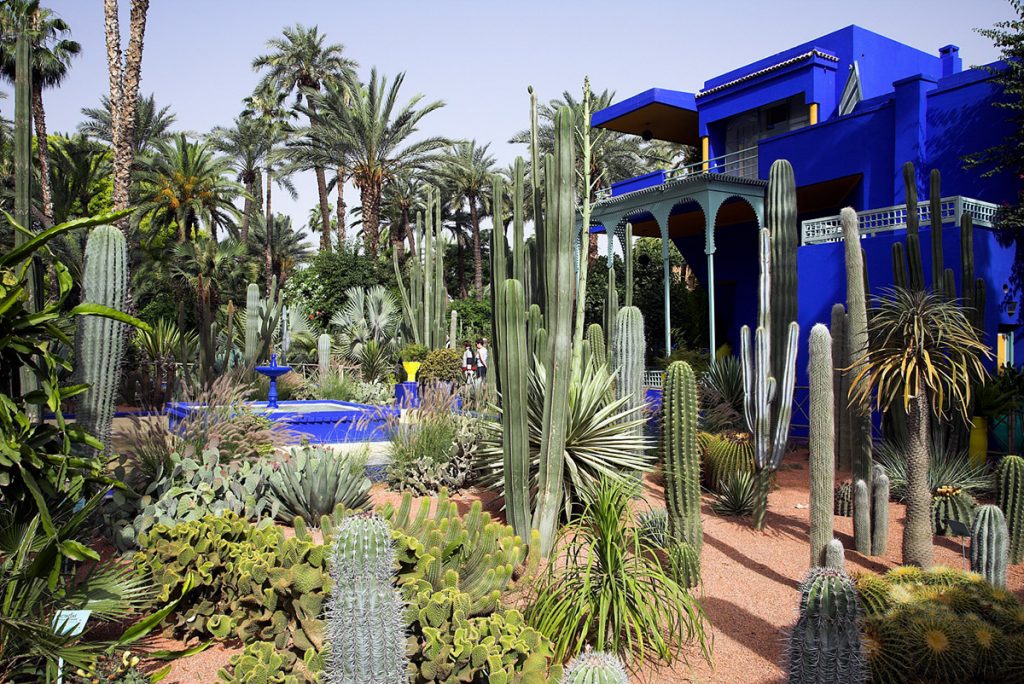
The Jardin Majorelle, a 20th-century landscape garden masterpiece that French Orientalist artist Jacques Majorelle created and cultivated for almost 40 years, blends Art Deco and Moorish influences, painted in a distinct tone of Majorelle Blue, the artist’s trademark color. Restored to life by fashion designers Yves Saint Laurent and Pierre Berge, the property boasts over 100 plant species from five continents including yucca, jasmine, and coconut trees, and a Cubist-style villa that French architect Paul Sinoir created for the Majorelle.
Another must-see Marrakech spot is Palais Bahia, a labyrinth-like, late-19th-century triumph of architecture, featuring reception halls decorated with zellij tilework, a marble-tiled Grand Courtyard, and intricately painted cedar-wood ceiling panels. This 150-room palace (originally built for the sultan’s grand vizier, Si Musa) is one of the country’s most splendid examples of Andalusian and Moorish architectural stylings.
9. Travel an ancient trade route in Ouarzazate
Traverse Morocco on an ancient trans-Saharan trade route once traveled by thousands of camels that carried with them such commodities as gold, salt, and copper between the 8th and the 16th centuries. The most legendary of the country’s caravan routes lies between Marrakech and the Sahara gateway of Ouarzazate, an oasis of foreign filmmaking due to its exquisite desert scenery (in fact, the famed Atlas Studios is located nearby). This “Route of the Kasbahs” is a winding drive past hundreds of fortifications interspersed among palm groves, desert plains, and Berber villages on the slopes of the High Atlas Mountains.
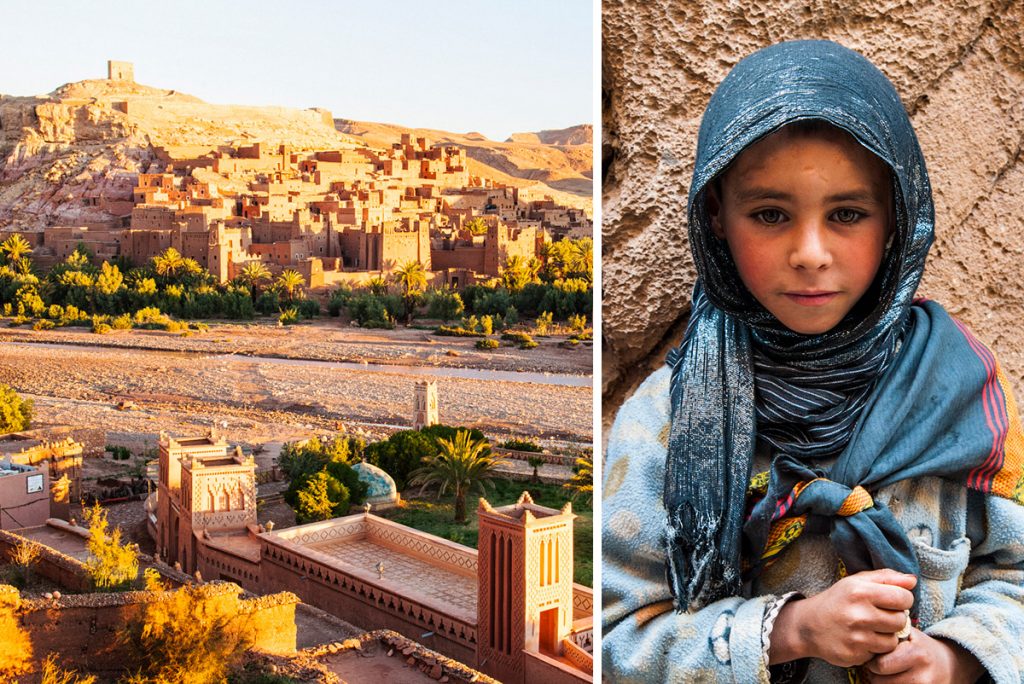
One of the most legendary is the awe-inspiring Ait Benhaddou, a UNESCO-listed, centuries-old ksar built from rammed earth and decorated with clay-brick geometric motifs. It’s an exquisite example of Moroccan earthen clay architecture.
10. Take part in Moroccan culture
The best way to truly experience the culture of this magnificent country is to delve right in. Learn how to say key phrases like “hello” (marhaba) and “thank you” (shukran) in Arabic and try your hand at conversing with locals. Get to know customs for bartering like a pro with assistance from your expert guide, who can direct you as to how and when to barter, determining a price that works for both you and the vendor, and why drinking tea with them and making conversation is important. Understand the etiquette of visiting Morocco’s holy sites, including covering your shoulders (a scarf works well) and your upper legs. GeoEx can arrange a meeting with an imam, who can share the intricacies as well as the significance of Ramadan and the rituals that take place during the holy month. You might engage in a “break the fast” cooking class in Marrakech that focuses on foods eaten during Ramadan and a sundown meal to celebrate, or take a guided tour of one of the few mosques that are open to non-Muslims, such as the enormous Hassan II Mosque in Casablanca.
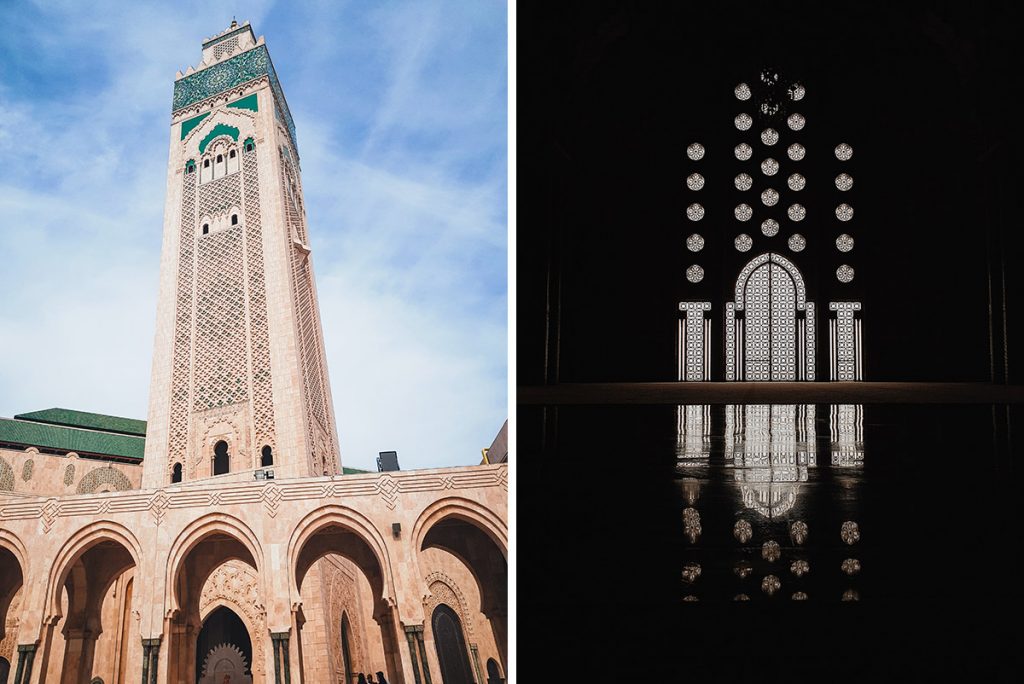
Another good thing to master is who and when to tip (for example, it’s customary to tip porters who help you through the medina, as well as the guide at the end of your trip). But not to worry: GeoEx will provide you tipping guidelines prior to your travels, so that you can arrive in the know, ready to be a part of the place around you.
* * * * *
For more information on our Morocco luxury tours, call our travel experts at 888-570-7108.
Great post! Thank you so much for sharing it. This article is really amazing, thank you for sharing helpful article. very interesting and amazing details you provide. Excellent Explanation with Wonderful Images.
Excellent description!! Thank you!!! 😉
Cool post!! Thanks for sharing this amazing article!
Exciting article. I will try all these things when I visit Morocco.
Beautiful blog! Thanks for sharing.

